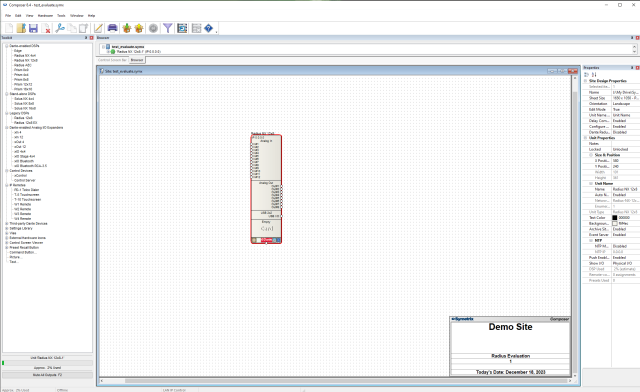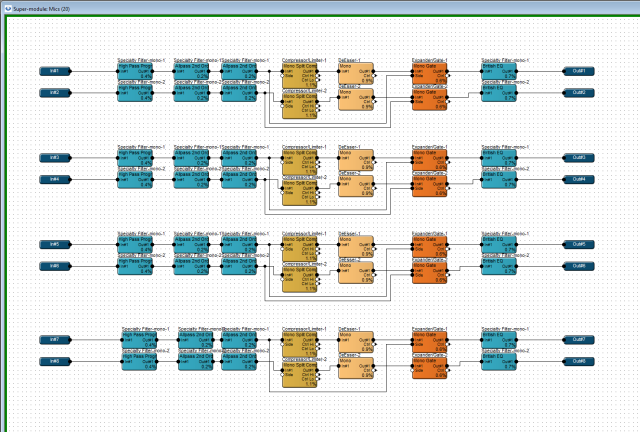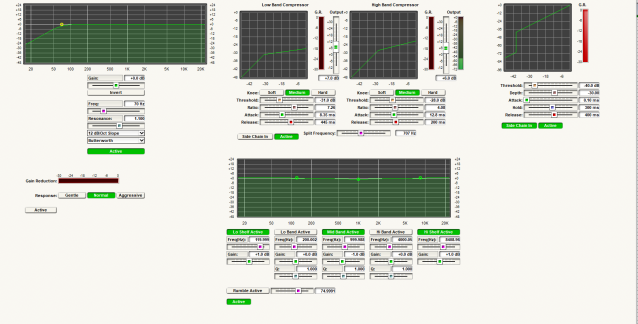Symetrix Radius NX 12×8 Part 2
Well, the holidays are upon us. Thanksgiving has flown by. How about some light reading. The Radius NX has been on the air on two stations for a few months now. No complaints. I do continue to think of ways to improve the sound, but if it works, lets not play too much, right?
I introduced the Symetrix in a previous post and here we will discuss the overall configuration of the unit. No this is not a box you just plug in and play like a discrete unit. This is a configurable DSP unit, so you need the tools to make it work. A drawback to modern technology and its flexibility is it requires the tools to do it. In the case of Symetrix their CAD like program is Composer. I started BEFORE I even received the hardware by downloading Composer from their site. This way I was able to poke and prod and start to learn what needs to be done.

As seen in the image, the workspace is very CAD-like which does make sense if you ponder it. The left side provides a toolkit. At the start you choose the DSP device of which to program. In my case the DSP is the Radius NX 12×8. Drag and drop in the workspace. Alternate click, aka Right-Click, and the basics of the device can be configured. I want to give a full tutorial, but really this is an overview. If you wish a more detailed description, or a tutorial type posting, please send a note and I can pursue a new site section for the crowd.
Moving on, double-click the DSP in the workspace opens the DSP configuration. This is the design view. Now the world of options opens up for you. The toolkit on the right changes with a number of DSP options or plug-ins to use. Many audio related, many facilities related. Remember Symetrix provides for the AV world and conference centers and business conference rooms are a big part of their business. As we are concentrating on broadcast studio use, we do not use the like of Loudspeaker management or Conferencing and paging.

You will also see the basics of the DSP unit, input and output “blocks”, and it will show Dante and AES if such options are installed. Open the Analog Ins by double clicking, same with the Analog Outs, and you see the controls for the I/O. From the toolkit you drag and drop in the modules, or blocks, which you wish to use.


I learned early on that designing from here can get quite messy. Just think of the modules you can have in this screen! After research, and around this time I was in contact with Symetrix, I learned about the Super-Module. Think of this as your container with the necessary, lets call them sub-modules, you wish to use in one package. In our case, we have 5 to 6 microphones in a control room, so if you did not create a super-module, you would have that many processing chains in this main design view, and what a view that would be. Package that into a super-module, then you see one of those, open that module up, and you build your chains out within that.
The next screenshot is after dropping in and configuring a new Super Module. Within this the audio I/O is filled based on the number of I/O you configure when creating it. Here we see 8 in and 8 out. Then you drag and drop the modules you wish to use; compressor, EQ, filters, and whatever complex stuff you wish to configure. Copy and paste? Yes. Makes things go faster, and if you have start-point settings, configure those first, then copy and past. Talk about saving time!

Once you add the audio path lines and save it all, you get audio in and audio out. The input gain and output trim interface with your external equipment, but once your audio is in, the DSP is all floating point, so there is almost unlimited gain. Just do not go crazy. I do the old fashioned approach by setting up my input and output, then make my changes to align with the external world after adjustment of the details.
Here is an EQ example. A specialty filter, or basically a pre-configured EQ module as you can build one yourself. All the settings are done for you and you can choose the type of EQ at each stage. This guy is a 5-band EQ. As you can see this becomes quite customizable.


That second image is a dual compressor/limiter that I have found to play with. Again a pre-loaded module. Easy to configure. Graphical. Note many of these modules have a side chain input. Use a different audio point to activate the module is pretty cool. Modules also have control inputs and those are used if you have zones and other types of controls to activate, etc. Not important, per se, to broadcast.
Once all this is done, you save it and upload it to the unit. If you have multiple units, you choose which one it goes to. Afterwards you can use Composer to make adjustments when you connect again. If you wish, you can save these “views” in SymView. When you run that, you connect directly and you have real-time changes without having to get into Composer. I for this I basically dropped, or exported, the settings to the SymView design.

After getting over that learning curve, which I will admit was daunting to start before having the hardware in hand, it became quite easy to navigate and move around. When I received our second unit, I had it up and running in no time. So far the talent in the studios that have a Symetrix NX in it have not complained. If asked for an adjustment, I am able to open the SymView for that installation and play. What worked out so well is I had it on my laptop. Walked into the room and had him yap while monitoring the appropriate bus, made a couple tweaks, and done. If you have remote access to your network, or a computer on the network, you can do these changes remotely, too. I have not been asked, but that day will come. At this point, if you are looking for a good unit with features galore, you can replace a number of single purpose boxes with a very versatile unit, I recommend the Symetrix. I feel I have come full circle when there was a time I had the trusted 528e.
Cheers!